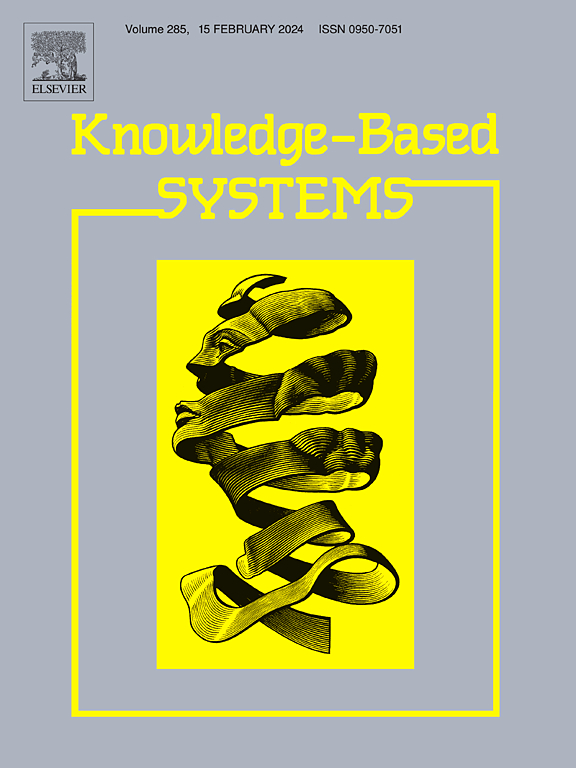Automated multiple sclerosis progression rate computation of a patient from 2D FLAIR images with Rayleigh-Weibull-Fuzzy imaging and augmented morphing method
IF 7.2
1区 计算机科学
Q1 COMPUTER SCIENCE, ARTIFICIAL INTELLIGENCE
引用次数: 0
Abstract
Multiple sclerosis (MS) is a neurological demyelinating disorder affecting brain and spinal cord by attacking the myelin sheaths of nerves. Estimation of the volumetric changes in MS lesions is a challenging and specialized task which is executed and judged by medical experts. The change in the volume of the lesions provides crucial information on MS progression or regression by comparing the magnetic resonance images (MRI) taken in successive scans. However, visual comparison of the images, even with an expert eye, would not always lead to a conclusive decision nor a consensus on progression or regression. Therefore, we present an automated expert system for estimating MS progression rate by automatic lesion segmentation and volume estimation using two-dimensional MRIs, which is also adaptable to various parameters, slice thickness and increment. A clinical dataset is specially formed for this research which contains three sets of 135 MR images of an MS patient generated within approximately 23- and 6-month periods consecutively with identical device parameters. The lesions are segmented by a novel Rayleigh-Weibull-Fuzzy (RWF) imaging method based on the Nakagami distribution and specialized fuzzy 2-means. Subsequently, the segmentation module is trained to fit the ground truths images created by experts to achieve the highest dice score possible for a total number of 56 images containing lesions, which is found as 93.76 %. Afterwards, several imaginary image sequences are generated by augmented linear and nonlinear morphing for re-segmentation of imaginary lesions by RWF. Finally, we estimated the volumetric change between the first two MRI sequences to adjust the morphing module and to predict the progression rate of the lesions in time. The framework automatically selected the highest accuracy, which is 99.9 % in the training session and estimated the progression rate in the testing phase with 99.69 % accuracy, which are not achievable without augmented morphing methodology. For the first time in the literature, an automated framework could estimate the MS progression rate from the raw MR images, which is also the main innovation of this paper and the outputs would be beneficial for the experts working on this field.
利用 Rayleigh-Weibull-Fuzzy 成像和增强变形法,从二维 FLAIR 图像自动计算一名患者的多发性硬化症进展率
多发性硬化症(MS)是一种神经系统脱髓鞘疾病,通过破坏神经的髓鞘影响大脑和脊髓。多发性硬化病灶体积变化的估算是一项具有挑战性的专业任务,需要由医学专家来执行和判断。通过比较连续扫描的磁共振图像(MRI),病灶体积的变化为多发性硬化症的进展或消退提供了重要信息。然而,即使是通过专家的肉眼对图像进行比较,也并不总能得出结论,或就进展或消退达成共识。因此,我们提出了一种自动专家系统,通过使用二维核磁共振成像进行自动病灶分割和体积估算,来估算多发性硬化症的进展率,该系统还能适应各种参数、切片厚度和增量。这项研究专门建立了一个临床数据集,其中包含一名多发性硬化症患者在大约 23 个月和 6 个月期间连续生成的三组 135 幅 MR 图像,设备参数完全相同。病变是通过一种基于中神分布和专门模糊 2 均值的新型 Rayleigh-Weibull-Fuzzy (RWF) 成像方法分割的。随后,对分割模块进行训练,以拟合专家创建的地面实况图像,从而在总共 56 幅包含病变的图像中获得尽可能高的骰子分数,结果发现骰子分数为 93.76%。然后,通过增强线性和非线性变形生成多个假想图像序列,以便利用 RWF 对假想病灶进行重新分割。最后,我们估算了前两个核磁共振成像序列之间的体积变化,以调整变形模块,并预测病变在时间上的进展率。该框架在训练阶段自动选择了准确率最高的 99.9%,在测试阶段估算病变进展率的准确率为 99.69%,而这些准确率在没有增强变形方法的情况下是无法实现的。这也是本文的主要创新之处,其结果将对该领域的专家有所帮助。
本文章由计算机程序翻译,如有差异,请以英文原文为准。
求助全文
约1分钟内获得全文
求助全文
来源期刊

Knowledge-Based Systems
工程技术-计算机:人工智能
CiteScore
14.80
自引率
12.50%
发文量
1245
审稿时长
7.8 months
期刊介绍:
Knowledge-Based Systems, an international and interdisciplinary journal in artificial intelligence, publishes original, innovative, and creative research results in the field. It focuses on knowledge-based and other artificial intelligence techniques-based systems. The journal aims to support human prediction and decision-making through data science and computation techniques, provide a balanced coverage of theory and practical study, and encourage the development and implementation of knowledge-based intelligence models, methods, systems, and software tools. Applications in business, government, education, engineering, and healthcare are emphasized.
 求助内容:
求助内容: 应助结果提醒方式:
应助结果提醒方式:


